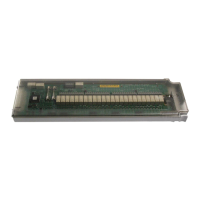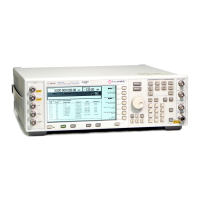1-108
Troubleshooting
RF Path Description (Frequency Generation, Level Control, and Modulation)
Pulse
Pulse modulation signals from the A11 Pulse/Analog Modulation Generator are routed directly to
the A8 Output and the A30 Modulation Filter pulse diodes. Pulse diodes must be biased on to pass
RF signals. Circuitry on the A8 Output and A30 Modulation Filter keep the pulse diodes turned on
in instruments that do not have modulation capability. Because ALC bandwidth is limited, the ALC
circuit can only level pulse widths >1 microsecond. To level pulse widths <1 microsecond, use search
mode. Search mode calibration sequencing is as follows:
1. Modulation is turned off.
2. The ALC feedback loop is closed and the RF power leveled.
3. The ALC feedback loop is opened and the integrated output voltage used to drive the ALC diodes
is maintained at the level determined during closed loop operation (step 2).
Changes in power level, frequency, or pulse settings cause the signal generator to repeat the search
mode leveling procedure and determine a new ALC diode drive level. Because drift in that leveling
circuit can occur over time in open-loop operation, it is not recommended to stay in search mode for
extended periods of time without closing the loop and refreshing the ALC diode drive voltage.
Digital Modulation
Digital modulation is produced using portions of the following three major assemblies:
• A14 Baseband Generator (Option 002/602)
• A13 I/Q Multiplexer
•A8 Output
Together, these assemblies generate and route the baseband signals to the I/Q modulators located
on the A8 Output and the A35 I/Q Modulator. The A8 Output modulates carrier signals form
250 kHz to 3.2 GHz, while the A35 I/Q Modulator modulates carrier signals form 3.2 to 20 GHz. The
A14 Baseband Generator (Option 002/602) comprises data generation, burst control, and symbol
building circuitry. The output section of the A14 Baseband Generator consists of two 16–bit DACs:
one for the I signal and one for the Q signal. The data produced from these I/Q signals is converted
to analog, amplified, and filtered before being routed to the A13 I/Q Multiplexer. The I/Q signals are
routed from the A13 I/Q Multiplexer to the I/Q modulators, located on the A8 Output and the A35
I/Q Modulator. These I/Q signals modulate the main RF signal.
A14 Baseband Generator (Option 002/602)
The A14 Baseband Generator may be used as a dual arbitrary waveform generator, a real time I/Q
baseband generator, a noise generator, or a multitone generator. Customer–supplied waveforms can
be downloaded into the waveform memory to generate customized formats.
The I/Q bandwidth is 80 MHz for internally–generated signals, and 160 MHz for
externally–generated I/Q signals. The A14 Baseband Generator can generate symbol rates of up to
6.25 Msymbol/sec, and has 32 Msamples of waveform memory.
Data is sequenced from waveform memory by the field programmable gate array block (A1–FPGA),
passed on to the format builder block (A2–FPGA/Modulator/Filter), and finally to the output
section. I and Q DACs at the output convert the digital waveform data to analog. The I and Q output
DACs are driven by a sample clock generated by an on–board VCO. The VCO has a frequency range
of 200 to 400 MHz. A 10 MHz reference signal from the A7 Reference (or an external 10 MHz
reference) can be used to phase–lock the sample clock signal of the DACs.
The Burst Pulse signal from the A14 Baseband Generator goes to the A11 Pulse/Analog Modulation

